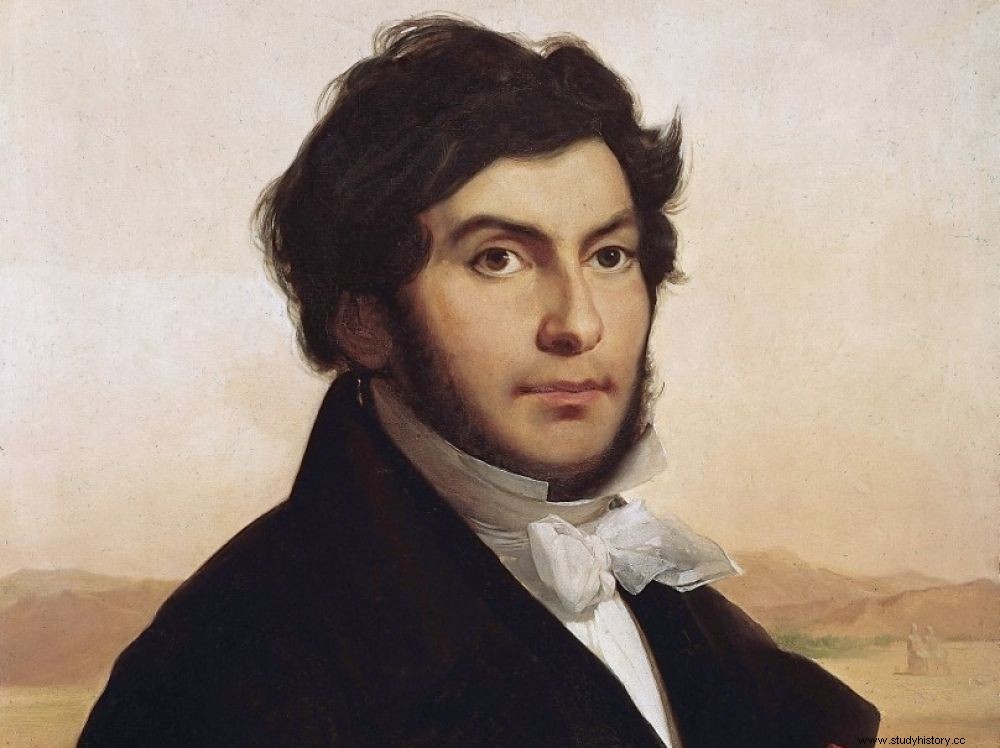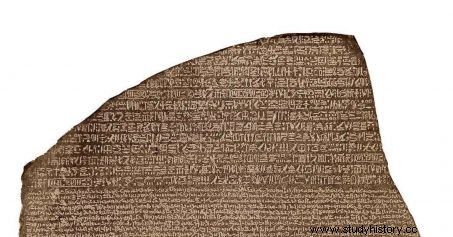A stele found during the Egyptian campaign. .. and a young scholar who lives only to decode the mysterious inscriptions. His triumph will allow Egyptology to take off.

Portrait of Jean-François Champollion (1790-1832), French Egyptologist, decipherer of hieroglyphs. Painting by Léon Cogniet (1794-1880). Louvre Museum.
This article is from the magazine Sciences et Avenir - Les Indispensables n°206, dated July/September 2021.
Champollion has never seen her! However, it was thanks to the Rosetta Stone that he was able to decipher the hieroglyphs... The adventure began without him, with the Egyptian campaign of 1798. Bonaparte, anxious to add a scientific dimension to this expedition above all military and political, and to be part of the line of great discoverers, embarked 160 scholars. A first ! On August 20, less than two months after landing in Alexandria, he asked scholars to form the Institute of Egypt in Cairo, founded to "deal with the progress and propagation of the Enlightenment in Egypt" . Three days later, he chaired the first meeting!
A large black stele covered with inscriptions
A year later the Institute of Egypt received news:as part of work to renovate the citadel of the city of Rosette (Rashid), in the Nile delta, Lieutenant Pierre Bouchard discovered a large black stele covered with inscriptions:hieroglyphs in the upper part, Greek in the lower part, and demotic - simplified writing of the ancient Egyptians, which has not yet been deciphered - in the center. "The first announcement at the Institute went relatively unnoticed, emphasizes Dominique Valbelle, Emeritus Professor of Egyptology at Sorbonne University.
This article is from the magazine Sciences et Avenir - Les Indispensables n°206, dated July/September 2021.
Champollion has never seen her! However, it was thanks to the Rosetta Stone that he was able to decipher the hieroglyphs... The adventure began without him, with the Egyptian campaign of 1798. Bonaparte, anxious to add a scientific dimension to this expedition above all military and political, and to be part of the line of great discoverers, embarked 160 scholars. A first ! On August 20, less than two months after landing in Alexandria, he asked scholars to form the Institute of Egypt in Cairo, founded to "deal with the progress and propagation of the Enlightenment in Egypt" . Three days later, he chaired the first meeting!
A large black stele covered with inscriptions
A year later the Institute of Egypt received news:as part of work to renovate the citadel of the city of Rosette (Rashid), in the Nile delta, Lieutenant Pierre Bouchard discovered a large black stele covered with inscriptions:hieroglyphs in the upper part, Greek in the lower part, and demotic - simplified writing of the ancient Egyptians, which has not yet been deciphered - in the center. "The first announcement at the Institute went relatively unnoticed, emphasizes Dominique Valbelle, Emeritus Professor of Egyptology at Sorbonne University. Specialists recognize the exceptional character of the stone and begin to study it. But they go around in circles. Hieroglyphs are both phonetic and figurative. And those of the Rosetta stone, from a late period, transcribe more phonemes than in earlier times, which complicates the translation." From 1800, a copy of the inscriptions was nevertheless sent to the Institut de France in Paris. A happy initiative because, the following year, defeated by the English, the French had to leave Egypt and hand over to the victors their precious collection of ancient monuments… Including the Rosetta Stone, which arrived at the British Museum, where it is still on display. Scientists are therefore working on reproductions.
Twenty years later, the mystery remains
Then begins an exciting and passionate race. If the Greek text is quickly translated, the other two, on the other hand, resist:while the French orientalist Isaac Silvestre de Sacy identifies proper names in the demotic text, the Swedish David Akerblad and the English physicist Thomas Young manage to decipher some signs. But twenty years later… the mystery remains. He is only waiting for a young prodigy, Jean-François Champollion. This one, who masters ancient and oriental languages, began to study the Rosetta Stone in 1808, at the age of 18! "The difference between Champollion and the others is his relentlessness, believes Dominique Valbelle. Relying on the cartouches of Ptolemy and Cleopatra, he gradually widened his research, obtained the largest possible corpus of documents, went to Egypt to compare with other inscriptions. He owes his success to his courage and his vast culture." On September 27, 1822, Champollion announced to the secretary of the French Academy that he had found the key to deciphering this writing, which he defined as follows:"All at once figurative, symbolic and phonetic in the same text, in the same sentence, I would even say in the same word." Egyptology could take off.

Discovered in 1799 during the Egyptian campaign, deciphered twenty years later, this granite stele is engraved in three languages:hieroglyphs, demotic and ancient Greek. Credit:GAMMA RAPHO
